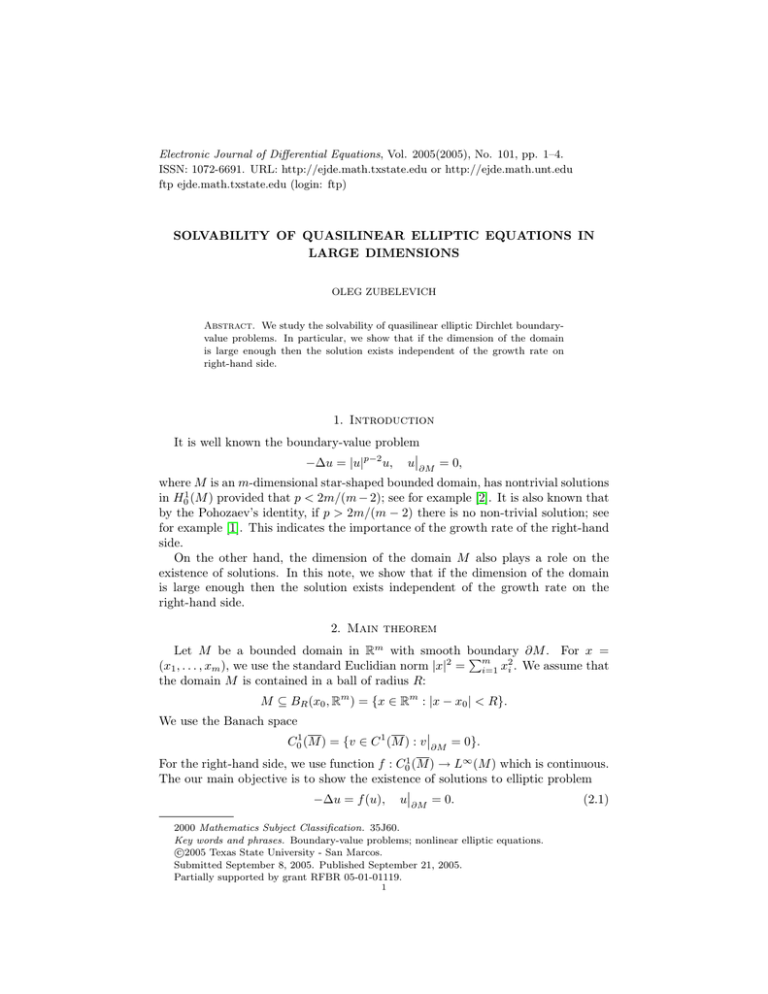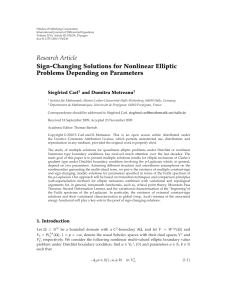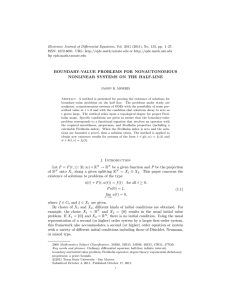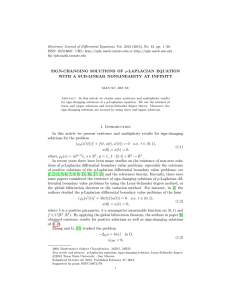Electronic Journal of Differential Equations, Vol. 2005(2005), No. 101, pp.... ISSN: 1072-6691. URL: or
advertisement

Electronic Journal of Differential Equations, Vol. 2005(2005), No. 101, pp. 1–4.
ISSN: 1072-6691. URL: http://ejde.math.txstate.edu or http://ejde.math.unt.edu
ftp ejde.math.txstate.edu (login: ftp)
SOLVABILITY OF QUASILINEAR ELLIPTIC EQUATIONS IN
LARGE DIMENSIONS
OLEG ZUBELEVICH
Abstract. We study the solvability of quasilinear elliptic Dirchlet boundaryvalue problems. In particular, we show that if the dimension of the domain
is large enough then the solution exists independent of the growth rate on
right-hand side.
1. Introduction
It is well known the boundary-value problem
−∆u = |u|p−2 u, u
∂M
= 0,
where M is an m-dimensional star-shaped bounded domain, has nontrivial solutions
in H01 (M ) provided that p < 2m/(m − 2); see for example [2]. It is also known that
by the Pohozaev’s identity, if p > 2m/(m − 2) there is no non-trivial solution; see
for example [1]. This indicates the importance of the growth rate of the right-hand
side.
On the other hand, the dimension of the domain M also plays a role on the
existence of solutions. In this note, we show that if the dimension of the domain
is large enough then the solution exists independent of the growth rate on the
right-hand side.
2. Main theorem
Let M be a bounded domain in Rm with smooth boundary
∂M . For x =
Pm
(x1 , . . . , xm ), we use the standard Euclidian norm |x|2 = i=1 x2i . We assume that
the domain M is contained in a ball of radius R:
M ⊆ BR (x0 , Rm ) = {x ∈ Rm : |x − x0 | < R}.
We use the Banach space
C01 (M ) = {v ∈ C 1 (M ) : v ∂M = 0}.
For the right-hand side, we use function f : C01 (M ) → L∞ (M ) which is continuous.
The our main objective is to show the existence of solutions to elliptic problem
−∆u = f (u), u
= 0.
(2.1)
∂M
2000 Mathematics Subject Classification. 35J60.
Key words and phrases. Boundary-value problems; nonlinear elliptic equations.
c
2005
Texas State University - San Marcos.
Submitted September 8, 2005. Published September 21, 2005.
Partially supported by grant RFBR 05-01-01119.
1
2
O. ZUBELEVICH
EJDE-2005/101
Theorem 2.1. Suppose there exists a constant λ such that for any v ∈ C01 (M )
with |v(x)| ≤ λ, the inequality
2mλ
R2
holds almost everywhere (a.e.) in M . Then problem (2.1) has a solution
\
e 2,r (M ) := H 1,r (M ) H 2,r (M ), r > m.
u∈H
0
|f (v)| ≤
(2.2)
As an example of a right-hand side that satisfies the conditions above, we have
f (u) = (2 + cos(|∇u|2 ))eu .
Let Mm ⊂ Rm , be a sequence of bounded domains with smooth boundaries and
inscribed in Euclidian balls with a given radius R. Let g : R → R be a continuous
function and f be mapping f (v) = g(v(x)).
Consider problem (2.1) with f defined on the domains Mm . We claim that in
such case problem (2.1) has a solution provided m is sufficiently large. Indeed,
take a positive constant λ and observe that the function g is bounded in the closed
interval [−λ, λ], thus inequality (2.2) will certainly be fulfilled, when the number
m is sufficiently large.
To illustrate this effect consider the example:
−∆u = ceu , u
(2.3)
m = 0,
∂B1 (0,R )
where c is a positive constant.
In the one-dimensional case, equation (2.3) can be integrated explicitly. However
the corresponding integrals can not be expressed by elementary functions. Numerical simulation of these integrals shows that the problem (2.3) has a solution if and
only if
c ≤ 0, 87845 . . .
On the other hand, applying Theorem 2.1 with |v(x)| ≤ λ one has:
cev ≤ ceλ ≤ 2mλ.
(2.4)
If
c ≤ 2e−1 m = m · 0.73575 . . .
then the second inequality of (2.4) has a solution λ. So letting c = 1, we see that
problem (2.3) has no solutions in the one-dimensional case, and by Theorem 2.1 it
has a solution for m ≥ 2.
To conclude, we note that by Proposition 3.1 (see below), the solution to (2.3)
is nonnegative.
3. Proof of Main Theorem
The arguments presented here are quite standard: We use a version of the comparison principle. Denote by ∆−1 h the solution of the problem
∆w = h ∈ H s,p (M ), w
= 0, s ≥ 0, p > 1.
∂M
e s+2,p (M ) is bounded.
It is well known that the linear mapping ∆−1 : H s,p (M ) → H
Now we construct a mapping
G(v) = −∆−1 f (v)
and look for a fixed point of this mapping.
EJDE-2005/101
ELLIPTIC EQUATIONS IN LARGE DIMENSIONS
3
e 2,r (M ) is continuous and by virtue
By the assumptions above, G : C01 (M ) → H
of the embeddings:
e 2,r (M ) @ H
e 2−δ,r (M ) ⊂ C01 (M ),
H
0 < δ < 1, (1 − δ)r > m,
(3.1)
(here @ is a completely continuous embedding) the mapping G : C01 (M ) → C01 (M )
is completely continuous.
Consider a function
λ
U (x) = 2 (R2 − |x − x0 |2 ).
R
This function takes positive values for x ∈ BR (x0 , Rm ), attains its maximum at x0 :
max
BR (x0 ,Rm )
U = U (x0 ) = λ,
and satisfy the Poisson equation
2mλ
.
R2
Let us recall a version of the maximum principle.
−∆U =
(3.2)
Proposition 3.1 ([3]). IF v ∈ H 1 (M ) and ∆v ≥ 0 then inequality v(x) ≤ 0 a.e.
in ∂M implies that v(x) ≤ 0 a.e. in M .
Lemma 3.2. The function G maps the set
W = {w ∈ C01 (M ) | |w(x)| ≤ λ,
x ∈ M}
e 2,r (M ).
to itself. Furthermore, the set G(W ) is bounded in H
Proof. Since −∆G(w) = f (w), by formula (3.2) one has
2mλ
∆(G(w) − U ) = −f (w) + 2 ≥ 0
R
a.e. in M . Observing that (G(w) − U ) ∂M = −U ∂M ≤ 0, by Proposition 3.1 we
see that G(w) ≤ U a.e. in M . The same arguments give −U ≤ G(w) a.e. in M .
Note that, a.e. in M , we have
|G(w)| ≤ U ≤
max
BR (x0 ,Rm )
U = λ.
By assumption of this Theorem, the set f (W ) is bounded in L∞ (M ); i.e., |f (W )| ≤
e 2,r (M ).
2mλ/R2 . Consequently the set ∆−1 f (W ) is bounded in H
Note that Lemma 3.2 and formula (3.1) imply the set G(W ) being precompact in
C01 (M ). Observing that W is a convex set, we apply Schauder’s fixed point theorem
e 2,r (M ).
to the mapping G : W → W and obtain desired fixed point u = G(u) ∈ H
This completes the proof of the main Theorem.
References
[1] S. I. Pohozaev; On the eigenfunctions of the equation ∆u + λf (u) = 0, Soviet Math. Dokl. 6
(1965), 1408-1411.
[2] P. H. Rabinowicz; Minimax Methods in Critical Point Theory with Applications to Differential
Equations, Regional Conference Series in Mathematics, American Mathematical Society, 1986.
[3] M. E. Taylor; Partial Differential Equations, Vol. 1, Springer, New York, 1996.
4
O. ZUBELEVICH
EJDE-2005/101
Oleg Zubelevich
Department of Differential Equations and Mathematical Physics, Peoples Friendship
University of Russia, Ordzhonikidze st., 3, 117198, Moscow, Russia
E-mail address: ozubel@yandex.ru
Current address: 2-nd Krestovskii Pereulok 12-179, 129110, Moscow, Russia










